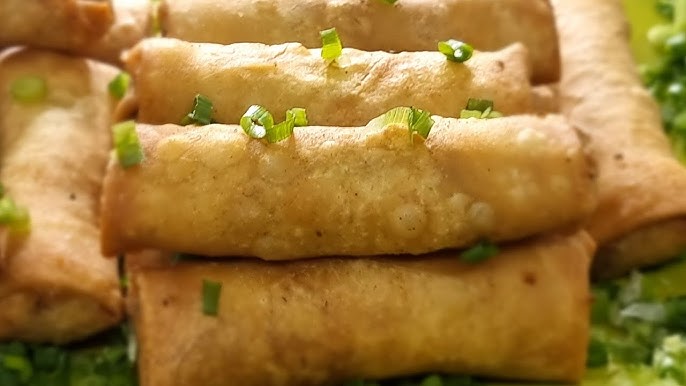Spring Roll Recipe: Spring rolls are a beloved appetizer and snack that have made their way into menus worldwide. Originating from East Asia, these delightful rolls are packed with flavorful fillings wrapped in a thin, crispy shell.
Whether you prefer them fried to golden perfection or enjoyed fresh, spring rolls are versatile and easy to customize. This guide will walk you through everything you need to know to make perfect spring rolls at home!
Ingredients Needed for Spring Rolls
For the Wrapper
- Spring roll wrappers (store-bought or homemade)
- Cornstarch or flour paste (for sealing)
For the Filling
- Vegetables: Carrots, cabbage, bell peppers, bean sprouts, or mushrooms
- Proteins: Cooked chicken, shrimp, pork, or tofu
- Garlic, ginger, and green onions for seasoning
- Soy sauce, oyster sauce, or hoisin sauce for flavor
- Sesame oil or vegetable oil for sautéing
For the Dips
- Sweet chili sauce
- Soy sauce mixed with a dash of vinegar
- Peanut dipping sauce
Preparing the Spring Roll Wrappers
If you’re using store-bought wrappers, ensure they are defrosted properly before use. However, making homemade wrappers can elevate your spring rolls.
Homemade Wrapper Recipe
Ingredients:
- 1 cup all-purpose flour
- 1/4 cup cornstarch
- 1 1/4 cups water
- A pinch of salt
Steps:
- Mix flour, cornstarch, salt, and water until you have a smooth batter.
- Heat a non-stick pan over medium-low heat.
- Pour a ladle of batter into the pan and swirl it to form a thin layer.
- Cook for 1-2 minutes until the wrapper is set but not browned.
- Cool and stack with parchment paper between each wrapper.
Choosing the Fillings
The beauty of spring rolls lies in their versatility. Here are some popular filling ideas:
Vegetarian Options
- Shredded carrots, cabbage, and bell peppers for a crunchy texture.
- Mushrooms or tofu for a savory depth.
Protein Fillings
- Stir-fried chicken strips seasoned with soy sauce.
- Shrimp sautéed with garlic and ginger.
- Ground pork cooked with hoisin sauce.
Balancing Flavors
Combine crisp vegetables with cooked proteins and seasonings for a balanced taste.
Preparing the Fillings
Vegetables:
- Julienne carrots, cabbage, and bell peppers into thin strips.
- Sauté lightly in sesame oil to soften, adding a pinch of salt and pepper.
Proteins:
- Cook chicken, shrimp, or pork in a skillet with garlic, ginger, and soy sauce until fully cooked.
- Let the filling cool before assembling to avoid soggy wrappers.
Assembling the Spring Rolls
Set Up:
- Place the wrappers, filling, and cornstarch paste on a clean surface.
- Keep a damp towel nearby to cover unused wrappers and prevent drying.
Layering:
- Lay a wrapper flat, placing 2-3 tablespoons of filling near one edge.
- Fold the sides inward, then roll tightly from bottom to top.
Seal:
- Dab the edge of the wrapper with cornstarch paste to seal the roll.
Cooking the Spring Rolls
Deep-Frying:
- Heat oil in a pan to 350°F (175°C).
- Fry rolls in batches until golden and crisp.
- Drain on paper towels.
Baking:
- Brush rolls with oil and bake at 400°F (200°C) for 20 minutes, turning halfway.
Fresh Spring Rolls:
- Use rice paper wrappers and serve immediately with dipping sauce.
Serving Suggestions
Spring rolls are not just about taste—they’re also about presentation. Here’s how you can make your serving stand out:
Plating and Garnishing
- Arrange spring rolls neatly on a platter with vibrant greens like lettuce or cilantro leaves as a base.
- Sprinkle sesame seeds or finely chopped scallions on top for added texture.
Dips and Sauces
- Sweet Chili Sauce: The classic companion to spring rolls.
- Peanut Sauce: Rich, nutty, and slightly sweet, this pairs beautifully with fresh spring rolls.
- Soy Sauce Mix: Add a splash of vinegar, sesame oil, and chopped chili for a tangy kick.
Pairing with Sides
- Serve with a side of Asian-inspired slaw or a bowl of hot soup for a complete meal.
- Pair with beverages like jasmine tea or a chilled glass of lemonade.
Tips and Tricks for Perfect Spring Rolls
Making perfect spring rolls can take a little practice. These tips will ensure you get it right every time:
Prevent Wrappers from Tearing:
- Avoid overfilling the rolls.
- Handle wrappers gently, especially if they’re homemade or rice paper-based.
Seal the Edges Properly:
- Use a cornstarch or flour paste for a strong seal, especially if frying.
- Press down firmly to ensure the edges stick.
Keep Rolls Crisp:
- Drain fried rolls on paper towels immediately to remove excess oil.
- Serve them hot to retain their crunch.
Dietary Adjustments:
- For gluten-free rolls, use rice paper wrappers.
- Swap regular soy sauce with tamari or coconut aminos for a gluten-free dip.
Variations of Spring Rolls
Spring rolls are found in various forms across different cuisines. Here are some popular variations to try:
Regional Styles
- Chinese Spring Rolls: Typically filled with a mix of vegetables and sometimes meat, deep-fried until golden.
- Vietnamese Fresh Spring Rolls: Made with rice paper and filled with fresh herbs, vermicelli, shrimp, or tofu.
- Thai Spring Rolls: Known for their spicy-sweet filling and peanut dipping sauce.
- Filipino Lumpia: A thinner wrapper and a savory filling of ground pork or beef.
Dietary Adaptations
- Vegan Spring Rolls: Use tofu or tempeh along with a variety of fresh vegetables.
- Gluten-Free Options: Opt for rice paper wrappers and gluten-free sauces.
Creative Twists
- Dessert Spring Rolls: Fill wrappers with sweet ingredients like bananas, chocolate, or cream cheese, then fry or bake.
- Breakfast Spring Rolls: Use scrambled eggs, bacon, and veggies for a morning treat.
Storing and Reheating Spring Rolls
Storing Uncooked Rolls:
- Place uncooked rolls on a tray lined with parchment paper, ensuring they don’t touch.
- Cover with plastic wrap and refrigerate for up to 24 hours.
Reheating Fried Spring Rolls:
- Reheat in an oven at 350°F (175°C) for 10-12 minutes to regain crispiness.
- Avoid microwaving, as it makes the rolls soggy.
Freezing Spring Rolls:
- Arrange uncooked rolls in a single layer, freeze until solid, then transfer to a freezer bag.
- Cook directly from frozen, adding a couple of minutes to the frying or baking time.
FAQs about Spring Roll Recipe
1. Can I prepare spring rolls in advance?
Yes, you can prepare the rolls ahead of time and refrigerate them for up to a day before cooking. If you’re making fresh spring rolls, assemble them shortly before serving to prevent the wrappers from drying out.
2. What can I use as a substitute for spring roll wrappers?
For fried spring rolls, you can use egg roll wrappers as an alternative. For fresh rolls, rice paper wrappers are a great option. Some even use large lettuce leaves for a low-carb version.
3. Are spring rolls healthy?
The healthiness depends on how they’re prepared. Fresh spring rolls are low in fat and packed with veggies, making them a nutritious choice. Fried versions, while delicious, are higher in calories due to the oil.
4. How do I prevent spring rolls from becoming soggy?
Ensure the fillings are dry before assembling. If frying, make sure the oil is hot enough to create a crispy outer layer without absorbing too much oil.
5. Can I bake spring rolls instead of frying them?
Absolutely! Baking is a healthier alternative. Brush the rolls lightly with oil and bake at 400°F (200°C) for about 20 minutes, flipping them halfway for even crispiness.
Conclusion
Spring rolls are a delightful treat that can be customized to suit any palate. Whether you enjoy them fried, fresh, or with a creative twist, they’re sure to impress family and friends. Follow this step-by-step guide to master the art of making spring rolls and enjoy this versatile dish at home.



